The State of Mental Health in Australia: Challenges and Interventions
VerifiedAdded on 2020/03/13
|11
|2773
|55
Essay
AI Summary
This essay provides an overview of mental health challenges in Australia, focusing on depression and suicide. It highlights the prevalence of these issues, including statistics on affected populations like new mothers, young people, and Aboriginal Australians. The essay explores various risk factors contributing to mental health problems, such as family history, isolation, sexual orientation, cyberbullying, substance abuse, and cultural factors. It also examines the case of Elizabeth, discussing the ethical considerations and interventions a nurse should consider, including hospitalization, counseling, and medication. Furthermore, the essay touches on the implications of the Mental Health Act of 2007 and interventions to manage anxiety and suicidal ideation. Overall, the essay underscores the urgent need for comprehensive mental health support and intervention strategies in Australia.
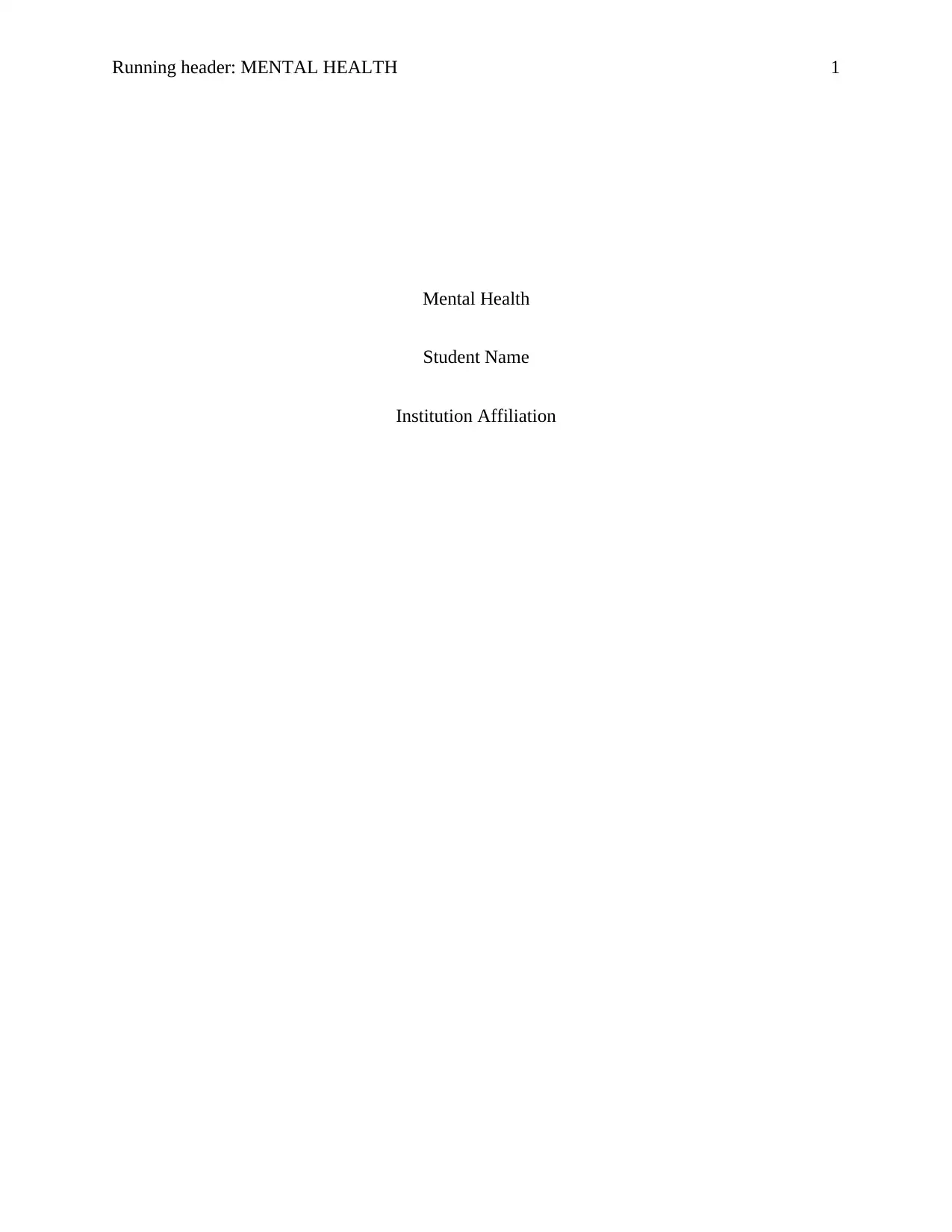
Running header: MENTAL HEALTH 1
Mental Health
Student Name
Institution Affiliation
Mental Health
Student Name
Institution Affiliation
Paraphrase This Document
Need a fresh take? Get an instant paraphrase of this document with our AI Paraphraser
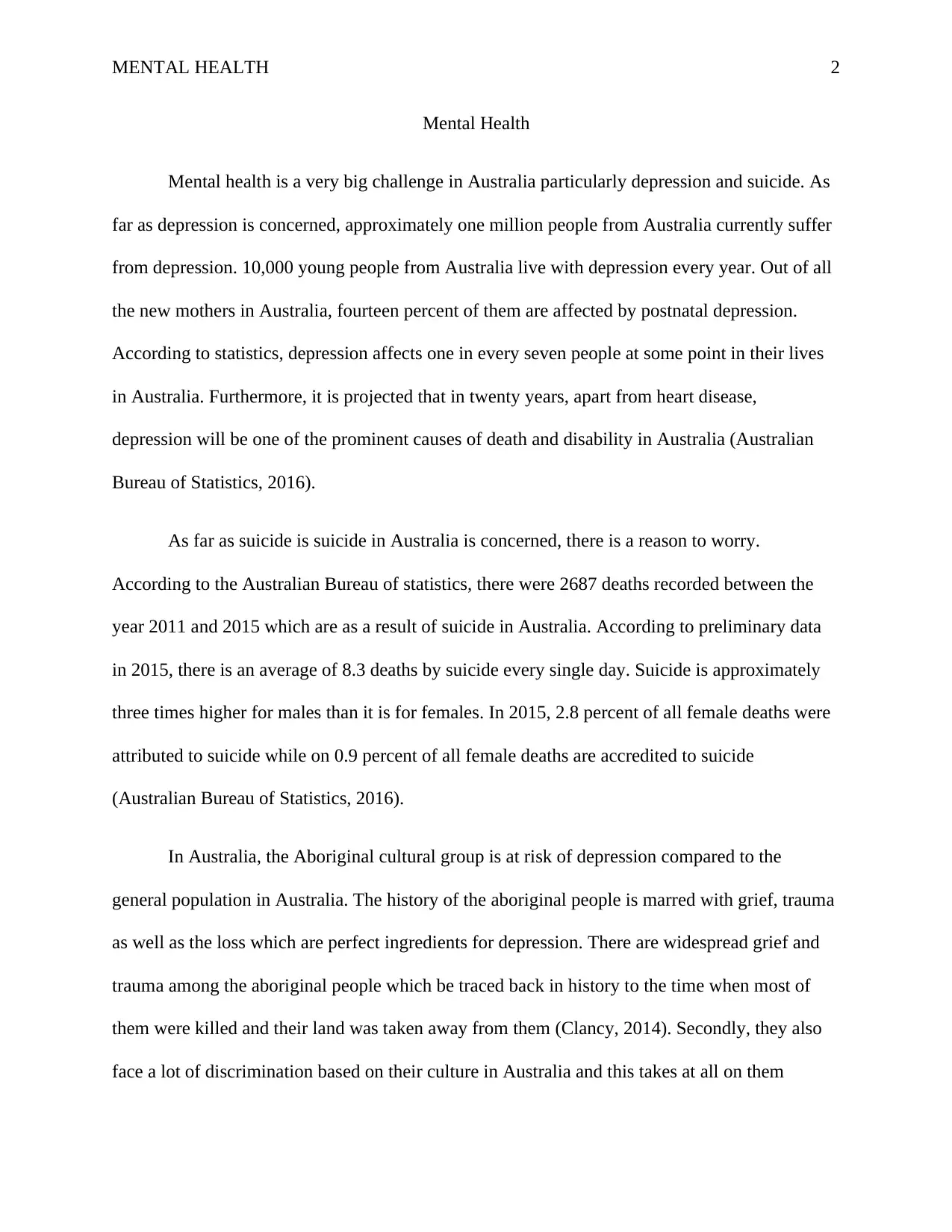
MENTAL HEALTH 2
Mental Health
Mental health is a very big challenge in Australia particularly depression and suicide. As
far as depression is concerned, approximately one million people from Australia currently suffer
from depression. 10,000 young people from Australia live with depression every year. Out of all
the new mothers in Australia, fourteen percent of them are affected by postnatal depression.
According to statistics, depression affects one in every seven people at some point in their lives
in Australia. Furthermore, it is projected that in twenty years, apart from heart disease,
depression will be one of the prominent causes of death and disability in Australia (Australian
Bureau of Statistics, 2016).
As far as suicide is suicide in Australia is concerned, there is a reason to worry.
According to the Australian Bureau of statistics, there were 2687 deaths recorded between the
year 2011 and 2015 which are as a result of suicide in Australia. According to preliminary data
in 2015, there is an average of 8.3 deaths by suicide every single day. Suicide is approximately
three times higher for males than it is for females. In 2015, 2.8 percent of all female deaths were
attributed to suicide while on 0.9 percent of all female deaths are accredited to suicide
(Australian Bureau of Statistics, 2016).
In Australia, the Aboriginal cultural group is at risk of depression compared to the
general population in Australia. The history of the aboriginal people is marred with grief, trauma
as well as the loss which are perfect ingredients for depression. There are widespread grief and
trauma among the aboriginal people which be traced back in history to the time when most of
them were killed and their land was taken away from them (Clancy, 2014). Secondly, they also
face a lot of discrimination based on their culture in Australia and this takes at all on them
Mental Health
Mental health is a very big challenge in Australia particularly depression and suicide. As
far as depression is concerned, approximately one million people from Australia currently suffer
from depression. 10,000 young people from Australia live with depression every year. Out of all
the new mothers in Australia, fourteen percent of them are affected by postnatal depression.
According to statistics, depression affects one in every seven people at some point in their lives
in Australia. Furthermore, it is projected that in twenty years, apart from heart disease,
depression will be one of the prominent causes of death and disability in Australia (Australian
Bureau of Statistics, 2016).
As far as suicide is suicide in Australia is concerned, there is a reason to worry.
According to the Australian Bureau of statistics, there were 2687 deaths recorded between the
year 2011 and 2015 which are as a result of suicide in Australia. According to preliminary data
in 2015, there is an average of 8.3 deaths by suicide every single day. Suicide is approximately
three times higher for males than it is for females. In 2015, 2.8 percent of all female deaths were
attributed to suicide while on 0.9 percent of all female deaths are accredited to suicide
(Australian Bureau of Statistics, 2016).
In Australia, the Aboriginal cultural group is at risk of depression compared to the
general population in Australia. The history of the aboriginal people is marred with grief, trauma
as well as the loss which are perfect ingredients for depression. There are widespread grief and
trauma among the aboriginal people which be traced back in history to the time when most of
them were killed and their land was taken away from them (Clancy, 2014). Secondly, they also
face a lot of discrimination based on their culture in Australia and this takes at all on them
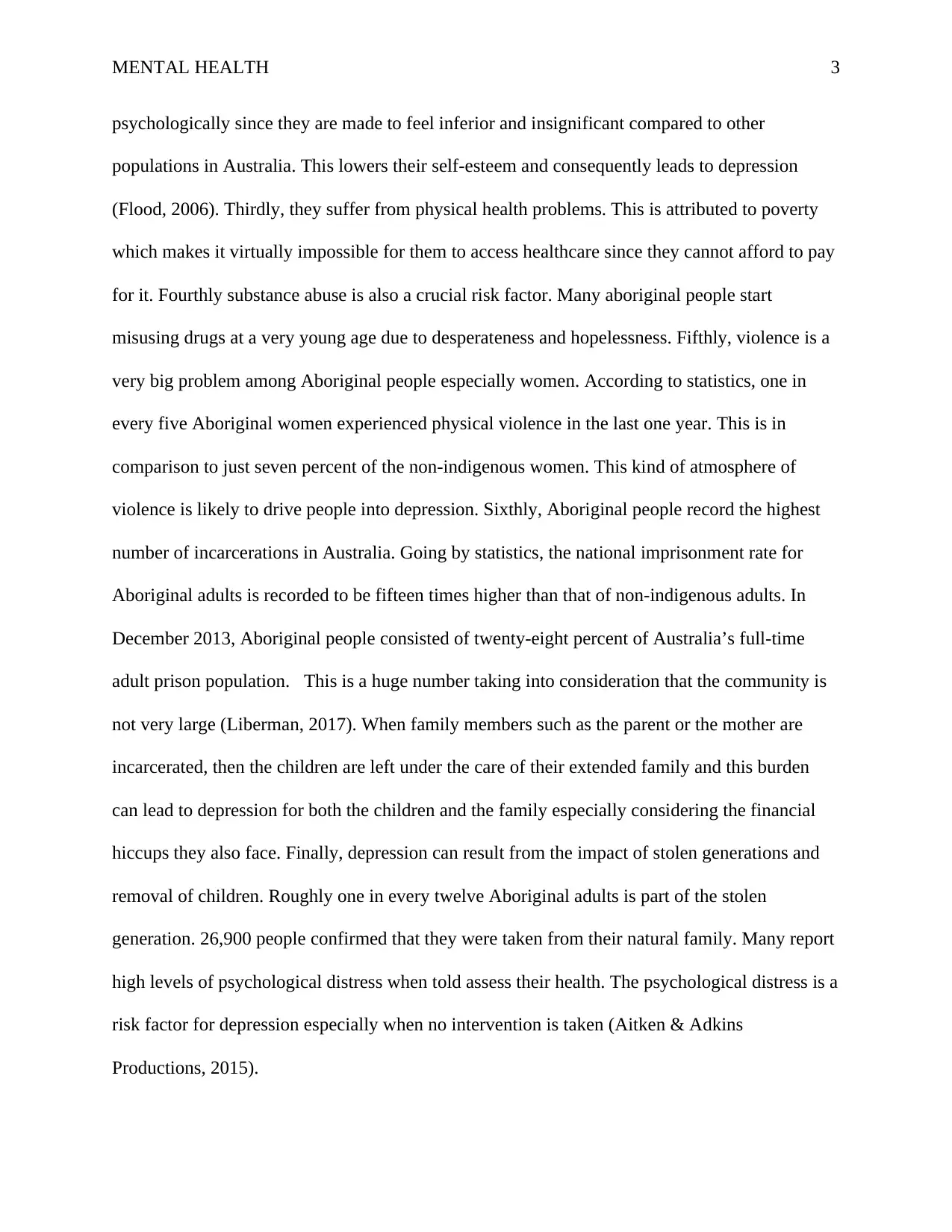
MENTAL HEALTH 3
psychologically since they are made to feel inferior and insignificant compared to other
populations in Australia. This lowers their self-esteem and consequently leads to depression
(Flood, 2006). Thirdly, they suffer from physical health problems. This is attributed to poverty
which makes it virtually impossible for them to access healthcare since they cannot afford to pay
for it. Fourthly substance abuse is also a crucial risk factor. Many aboriginal people start
misusing drugs at a very young age due to desperateness and hopelessness. Fifthly, violence is a
very big problem among Aboriginal people especially women. According to statistics, one in
every five Aboriginal women experienced physical violence in the last one year. This is in
comparison to just seven percent of the non-indigenous women. This kind of atmosphere of
violence is likely to drive people into depression. Sixthly, Aboriginal people record the highest
number of incarcerations in Australia. Going by statistics, the national imprisonment rate for
Aboriginal adults is recorded to be fifteen times higher than that of non-indigenous adults. In
December 2013, Aboriginal people consisted of twenty-eight percent of Australia’s full-time
adult prison population. This is a huge number taking into consideration that the community is
not very large (Liberman, 2017). When family members such as the parent or the mother are
incarcerated, then the children are left under the care of their extended family and this burden
can lead to depression for both the children and the family especially considering the financial
hiccups they also face. Finally, depression can result from the impact of stolen generations and
removal of children. Roughly one in every twelve Aboriginal adults is part of the stolen
generation. 26,900 people confirmed that they were taken from their natural family. Many report
high levels of psychological distress when told assess their health. The psychological distress is a
risk factor for depression especially when no intervention is taken (Aitken & Adkins
Productions, 2015).
psychologically since they are made to feel inferior and insignificant compared to other
populations in Australia. This lowers their self-esteem and consequently leads to depression
(Flood, 2006). Thirdly, they suffer from physical health problems. This is attributed to poverty
which makes it virtually impossible for them to access healthcare since they cannot afford to pay
for it. Fourthly substance abuse is also a crucial risk factor. Many aboriginal people start
misusing drugs at a very young age due to desperateness and hopelessness. Fifthly, violence is a
very big problem among Aboriginal people especially women. According to statistics, one in
every five Aboriginal women experienced physical violence in the last one year. This is in
comparison to just seven percent of the non-indigenous women. This kind of atmosphere of
violence is likely to drive people into depression. Sixthly, Aboriginal people record the highest
number of incarcerations in Australia. Going by statistics, the national imprisonment rate for
Aboriginal adults is recorded to be fifteen times higher than that of non-indigenous adults. In
December 2013, Aboriginal people consisted of twenty-eight percent of Australia’s full-time
adult prison population. This is a huge number taking into consideration that the community is
not very large (Liberman, 2017). When family members such as the parent or the mother are
incarcerated, then the children are left under the care of their extended family and this burden
can lead to depression for both the children and the family especially considering the financial
hiccups they also face. Finally, depression can result from the impact of stolen generations and
removal of children. Roughly one in every twelve Aboriginal adults is part of the stolen
generation. 26,900 people confirmed that they were taken from their natural family. Many report
high levels of psychological distress when told assess their health. The psychological distress is a
risk factor for depression especially when no intervention is taken (Aitken & Adkins
Productions, 2015).
⊘ This is a preview!⊘
Do you want full access?
Subscribe today to unlock all pages.

Trusted by 1+ million students worldwide
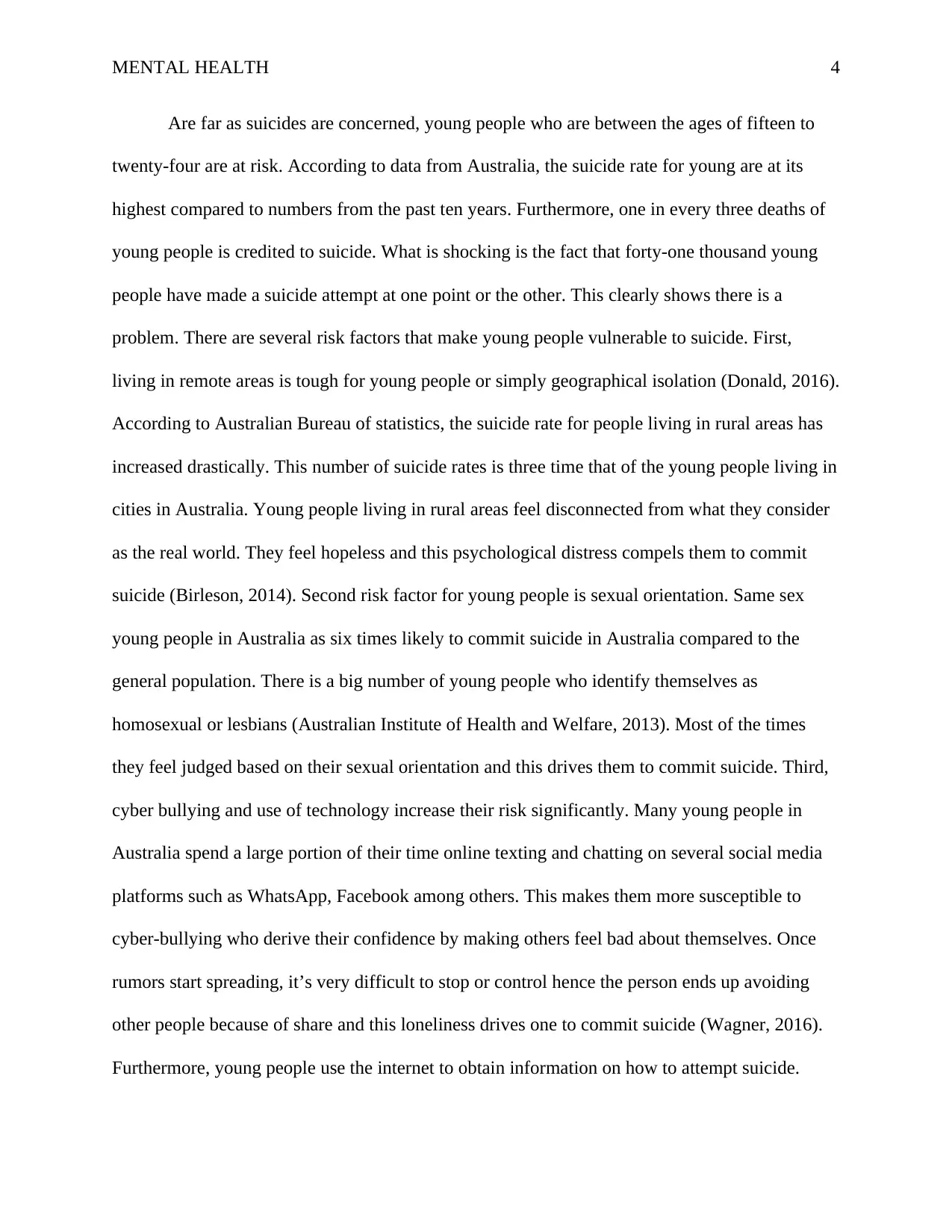
MENTAL HEALTH 4
Are far as suicides are concerned, young people who are between the ages of fifteen to
twenty-four are at risk. According to data from Australia, the suicide rate for young are at its
highest compared to numbers from the past ten years. Furthermore, one in every three deaths of
young people is credited to suicide. What is shocking is the fact that forty-one thousand young
people have made a suicide attempt at one point or the other. This clearly shows there is a
problem. There are several risk factors that make young people vulnerable to suicide. First,
living in remote areas is tough for young people or simply geographical isolation (Donald, 2016).
According to Australian Bureau of statistics, the suicide rate for people living in rural areas has
increased drastically. This number of suicide rates is three time that of the young people living in
cities in Australia. Young people living in rural areas feel disconnected from what they consider
as the real world. They feel hopeless and this psychological distress compels them to commit
suicide (Birleson, 2014). Second risk factor for young people is sexual orientation. Same sex
young people in Australia as six times likely to commit suicide in Australia compared to the
general population. There is a big number of young people who identify themselves as
homosexual or lesbians (Australian Institute of Health and Welfare, 2013). Most of the times
they feel judged based on their sexual orientation and this drives them to commit suicide. Third,
cyber bullying and use of technology increase their risk significantly. Many young people in
Australia spend a large portion of their time online texting and chatting on several social media
platforms such as WhatsApp, Facebook among others. This makes them more susceptible to
cyber-bullying who derive their confidence by making others feel bad about themselves. Once
rumors start spreading, it’s very difficult to stop or control hence the person ends up avoiding
other people because of share and this loneliness drives one to commit suicide (Wagner, 2016).
Furthermore, young people use the internet to obtain information on how to attempt suicide.
Are far as suicides are concerned, young people who are between the ages of fifteen to
twenty-four are at risk. According to data from Australia, the suicide rate for young are at its
highest compared to numbers from the past ten years. Furthermore, one in every three deaths of
young people is credited to suicide. What is shocking is the fact that forty-one thousand young
people have made a suicide attempt at one point or the other. This clearly shows there is a
problem. There are several risk factors that make young people vulnerable to suicide. First,
living in remote areas is tough for young people or simply geographical isolation (Donald, 2016).
According to Australian Bureau of statistics, the suicide rate for people living in rural areas has
increased drastically. This number of suicide rates is three time that of the young people living in
cities in Australia. Young people living in rural areas feel disconnected from what they consider
as the real world. They feel hopeless and this psychological distress compels them to commit
suicide (Birleson, 2014). Second risk factor for young people is sexual orientation. Same sex
young people in Australia as six times likely to commit suicide in Australia compared to the
general population. There is a big number of young people who identify themselves as
homosexual or lesbians (Australian Institute of Health and Welfare, 2013). Most of the times
they feel judged based on their sexual orientation and this drives them to commit suicide. Third,
cyber bullying and use of technology increase their risk significantly. Many young people in
Australia spend a large portion of their time online texting and chatting on several social media
platforms such as WhatsApp, Facebook among others. This makes them more susceptible to
cyber-bullying who derive their confidence by making others feel bad about themselves. Once
rumors start spreading, it’s very difficult to stop or control hence the person ends up avoiding
other people because of share and this loneliness drives one to commit suicide (Wagner, 2016).
Furthermore, young people use the internet to obtain information on how to attempt suicide.
Paraphrase This Document
Need a fresh take? Get an instant paraphrase of this document with our AI Paraphraser
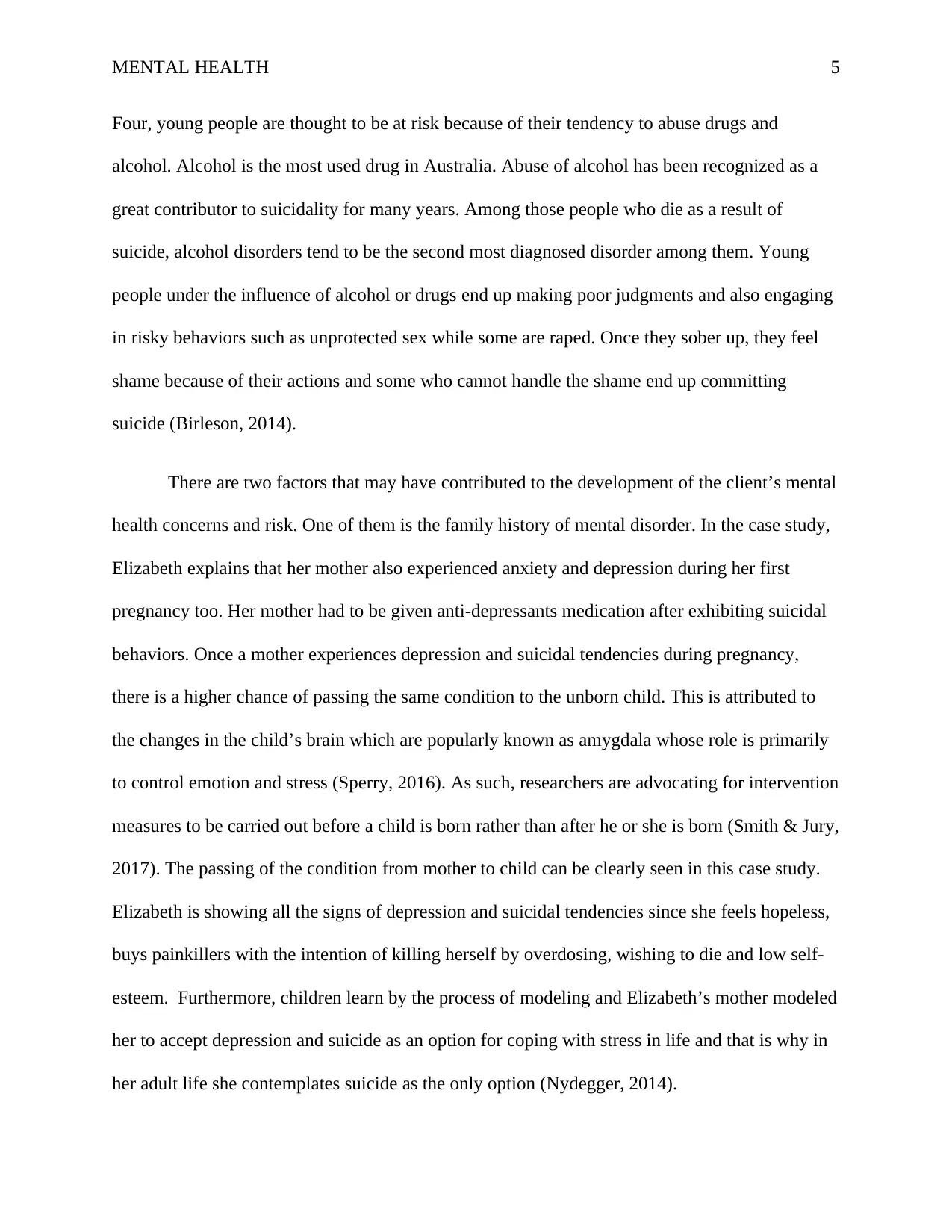
MENTAL HEALTH 5
Four, young people are thought to be at risk because of their tendency to abuse drugs and
alcohol. Alcohol is the most used drug in Australia. Abuse of alcohol has been recognized as a
great contributor to suicidality for many years. Among those people who die as a result of
suicide, alcohol disorders tend to be the second most diagnosed disorder among them. Young
people under the influence of alcohol or drugs end up making poor judgments and also engaging
in risky behaviors such as unprotected sex while some are raped. Once they sober up, they feel
shame because of their actions and some who cannot handle the shame end up committing
suicide (Birleson, 2014).
There are two factors that may have contributed to the development of the client’s mental
health concerns and risk. One of them is the family history of mental disorder. In the case study,
Elizabeth explains that her mother also experienced anxiety and depression during her first
pregnancy too. Her mother had to be given anti-depressants medication after exhibiting suicidal
behaviors. Once a mother experiences depression and suicidal tendencies during pregnancy,
there is a higher chance of passing the same condition to the unborn child. This is attributed to
the changes in the child’s brain which are popularly known as amygdala whose role is primarily
to control emotion and stress (Sperry, 2016). As such, researchers are advocating for intervention
measures to be carried out before a child is born rather than after he or she is born (Smith & Jury,
2017). The passing of the condition from mother to child can be clearly seen in this case study.
Elizabeth is showing all the signs of depression and suicidal tendencies since she feels hopeless,
buys painkillers with the intention of killing herself by overdosing, wishing to die and low self-
esteem. Furthermore, children learn by the process of modeling and Elizabeth’s mother modeled
her to accept depression and suicide as an option for coping with stress in life and that is why in
her adult life she contemplates suicide as the only option (Nydegger, 2014).
Four, young people are thought to be at risk because of their tendency to abuse drugs and
alcohol. Alcohol is the most used drug in Australia. Abuse of alcohol has been recognized as a
great contributor to suicidality for many years. Among those people who die as a result of
suicide, alcohol disorders tend to be the second most diagnosed disorder among them. Young
people under the influence of alcohol or drugs end up making poor judgments and also engaging
in risky behaviors such as unprotected sex while some are raped. Once they sober up, they feel
shame because of their actions and some who cannot handle the shame end up committing
suicide (Birleson, 2014).
There are two factors that may have contributed to the development of the client’s mental
health concerns and risk. One of them is the family history of mental disorder. In the case study,
Elizabeth explains that her mother also experienced anxiety and depression during her first
pregnancy too. Her mother had to be given anti-depressants medication after exhibiting suicidal
behaviors. Once a mother experiences depression and suicidal tendencies during pregnancy,
there is a higher chance of passing the same condition to the unborn child. This is attributed to
the changes in the child’s brain which are popularly known as amygdala whose role is primarily
to control emotion and stress (Sperry, 2016). As such, researchers are advocating for intervention
measures to be carried out before a child is born rather than after he or she is born (Smith & Jury,
2017). The passing of the condition from mother to child can be clearly seen in this case study.
Elizabeth is showing all the signs of depression and suicidal tendencies since she feels hopeless,
buys painkillers with the intention of killing herself by overdosing, wishing to die and low self-
esteem. Furthermore, children learn by the process of modeling and Elizabeth’s mother modeled
her to accept depression and suicide as an option for coping with stress in life and that is why in
her adult life she contemplates suicide as the only option (Nydegger, 2014).
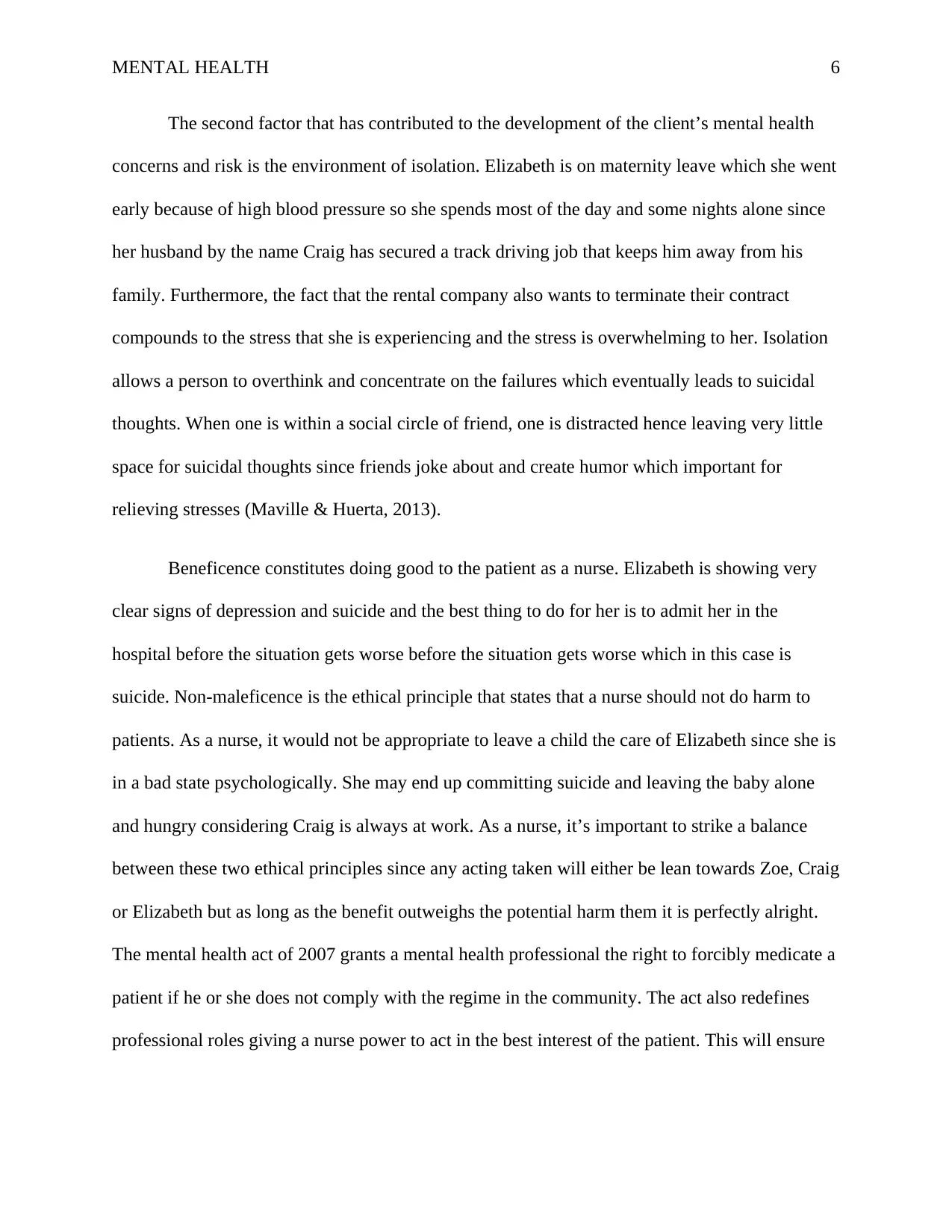
MENTAL HEALTH 6
The second factor that has contributed to the development of the client’s mental health
concerns and risk is the environment of isolation. Elizabeth is on maternity leave which she went
early because of high blood pressure so she spends most of the day and some nights alone since
her husband by the name Craig has secured a track driving job that keeps him away from his
family. Furthermore, the fact that the rental company also wants to terminate their contract
compounds to the stress that she is experiencing and the stress is overwhelming to her. Isolation
allows a person to overthink and concentrate on the failures which eventually leads to suicidal
thoughts. When one is within a social circle of friend, one is distracted hence leaving very little
space for suicidal thoughts since friends joke about and create humor which important for
relieving stresses (Maville & Huerta, 2013).
Beneficence constitutes doing good to the patient as a nurse. Elizabeth is showing very
clear signs of depression and suicide and the best thing to do for her is to admit her in the
hospital before the situation gets worse before the situation gets worse which in this case is
suicide. Non-maleficence is the ethical principle that states that a nurse should not do harm to
patients. As a nurse, it would not be appropriate to leave a child the care of Elizabeth since she is
in a bad state psychologically. She may end up committing suicide and leaving the baby alone
and hungry considering Craig is always at work. As a nurse, it’s important to strike a balance
between these two ethical principles since any acting taken will either be lean towards Zoe, Craig
or Elizabeth but as long as the benefit outweighs the potential harm them it is perfectly alright.
The mental health act of 2007 grants a mental health professional the right to forcibly medicate a
patient if he or she does not comply with the regime in the community. The act also redefines
professional roles giving a nurse power to act in the best interest of the patient. This will ensure
The second factor that has contributed to the development of the client’s mental health
concerns and risk is the environment of isolation. Elizabeth is on maternity leave which she went
early because of high blood pressure so she spends most of the day and some nights alone since
her husband by the name Craig has secured a track driving job that keeps him away from his
family. Furthermore, the fact that the rental company also wants to terminate their contract
compounds to the stress that she is experiencing and the stress is overwhelming to her. Isolation
allows a person to overthink and concentrate on the failures which eventually leads to suicidal
thoughts. When one is within a social circle of friend, one is distracted hence leaving very little
space for suicidal thoughts since friends joke about and create humor which important for
relieving stresses (Maville & Huerta, 2013).
Beneficence constitutes doing good to the patient as a nurse. Elizabeth is showing very
clear signs of depression and suicide and the best thing to do for her is to admit her in the
hospital before the situation gets worse before the situation gets worse which in this case is
suicide. Non-maleficence is the ethical principle that states that a nurse should not do harm to
patients. As a nurse, it would not be appropriate to leave a child the care of Elizabeth since she is
in a bad state psychologically. She may end up committing suicide and leaving the baby alone
and hungry considering Craig is always at work. As a nurse, it’s important to strike a balance
between these two ethical principles since any acting taken will either be lean towards Zoe, Craig
or Elizabeth but as long as the benefit outweighs the potential harm them it is perfectly alright.
The mental health act of 2007 grants a mental health professional the right to forcibly medicate a
patient if he or she does not comply with the regime in the community. The act also redefines
professional roles giving a nurse power to act in the best interest of the patient. This will ensure
⊘ This is a preview!⊘
Do you want full access?
Subscribe today to unlock all pages.

Trusted by 1+ million students worldwide
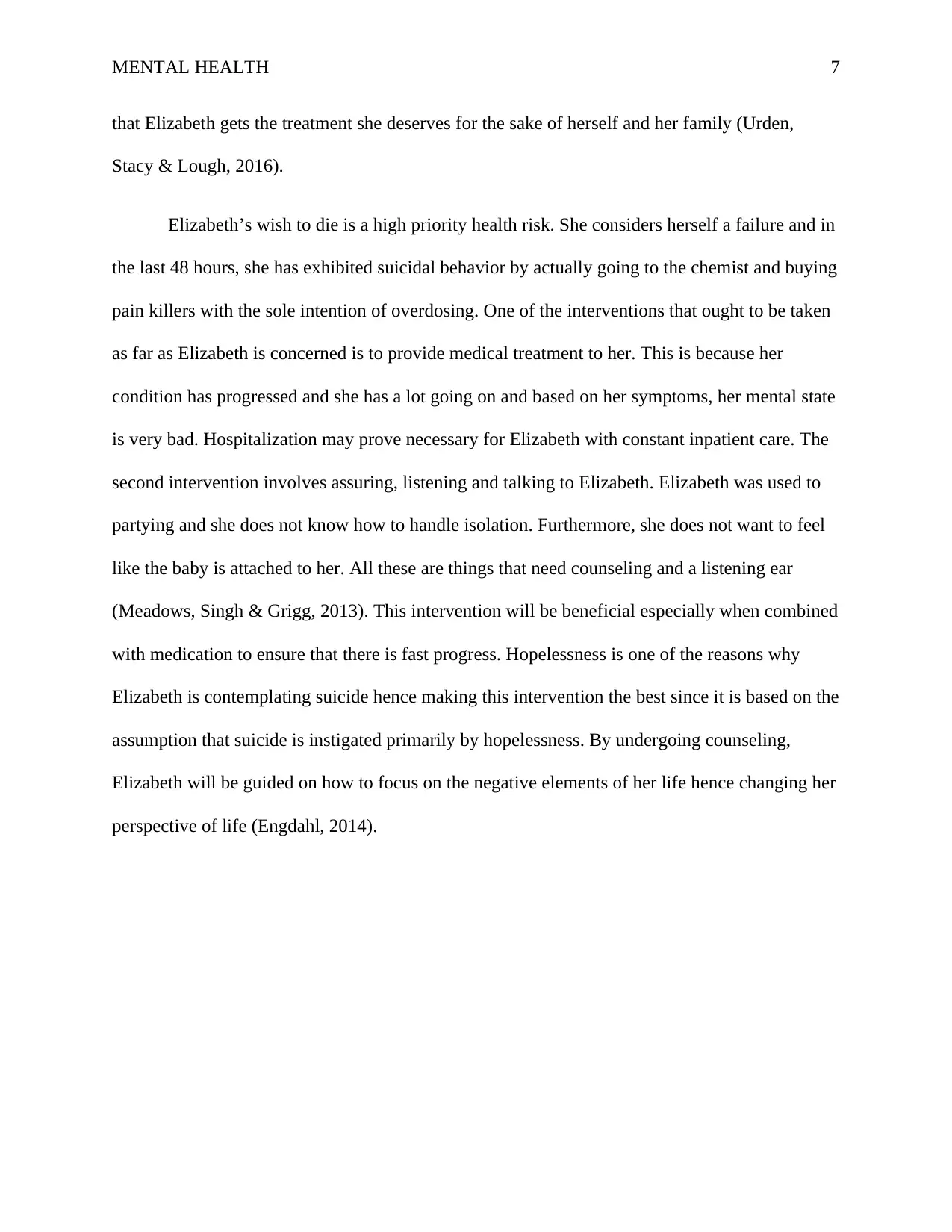
MENTAL HEALTH 7
that Elizabeth gets the treatment she deserves for the sake of herself and her family (Urden,
Stacy & Lough, 2016).
Elizabeth’s wish to die is a high priority health risk. She considers herself a failure and in
the last 48 hours, she has exhibited suicidal behavior by actually going to the chemist and buying
pain killers with the sole intention of overdosing. One of the interventions that ought to be taken
as far as Elizabeth is concerned is to provide medical treatment to her. This is because her
condition has progressed and she has a lot going on and based on her symptoms, her mental state
is very bad. Hospitalization may prove necessary for Elizabeth with constant inpatient care. The
second intervention involves assuring, listening and talking to Elizabeth. Elizabeth was used to
partying and she does not know how to handle isolation. Furthermore, she does not want to feel
like the baby is attached to her. All these are things that need counseling and a listening ear
(Meadows, Singh & Grigg, 2013). This intervention will be beneficial especially when combined
with medication to ensure that there is fast progress. Hopelessness is one of the reasons why
Elizabeth is contemplating suicide hence making this intervention the best since it is based on the
assumption that suicide is instigated primarily by hopelessness. By undergoing counseling,
Elizabeth will be guided on how to focus on the negative elements of her life hence changing her
perspective of life (Engdahl, 2014).
that Elizabeth gets the treatment she deserves for the sake of herself and her family (Urden,
Stacy & Lough, 2016).
Elizabeth’s wish to die is a high priority health risk. She considers herself a failure and in
the last 48 hours, she has exhibited suicidal behavior by actually going to the chemist and buying
pain killers with the sole intention of overdosing. One of the interventions that ought to be taken
as far as Elizabeth is concerned is to provide medical treatment to her. This is because her
condition has progressed and she has a lot going on and based on her symptoms, her mental state
is very bad. Hospitalization may prove necessary for Elizabeth with constant inpatient care. The
second intervention involves assuring, listening and talking to Elizabeth. Elizabeth was used to
partying and she does not know how to handle isolation. Furthermore, she does not want to feel
like the baby is attached to her. All these are things that need counseling and a listening ear
(Meadows, Singh & Grigg, 2013). This intervention will be beneficial especially when combined
with medication to ensure that there is fast progress. Hopelessness is one of the reasons why
Elizabeth is contemplating suicide hence making this intervention the best since it is based on the
assumption that suicide is instigated primarily by hopelessness. By undergoing counseling,
Elizabeth will be guided on how to focus on the negative elements of her life hence changing her
perspective of life (Engdahl, 2014).
Paraphrase This Document
Need a fresh take? Get an instant paraphrase of this document with our AI Paraphraser
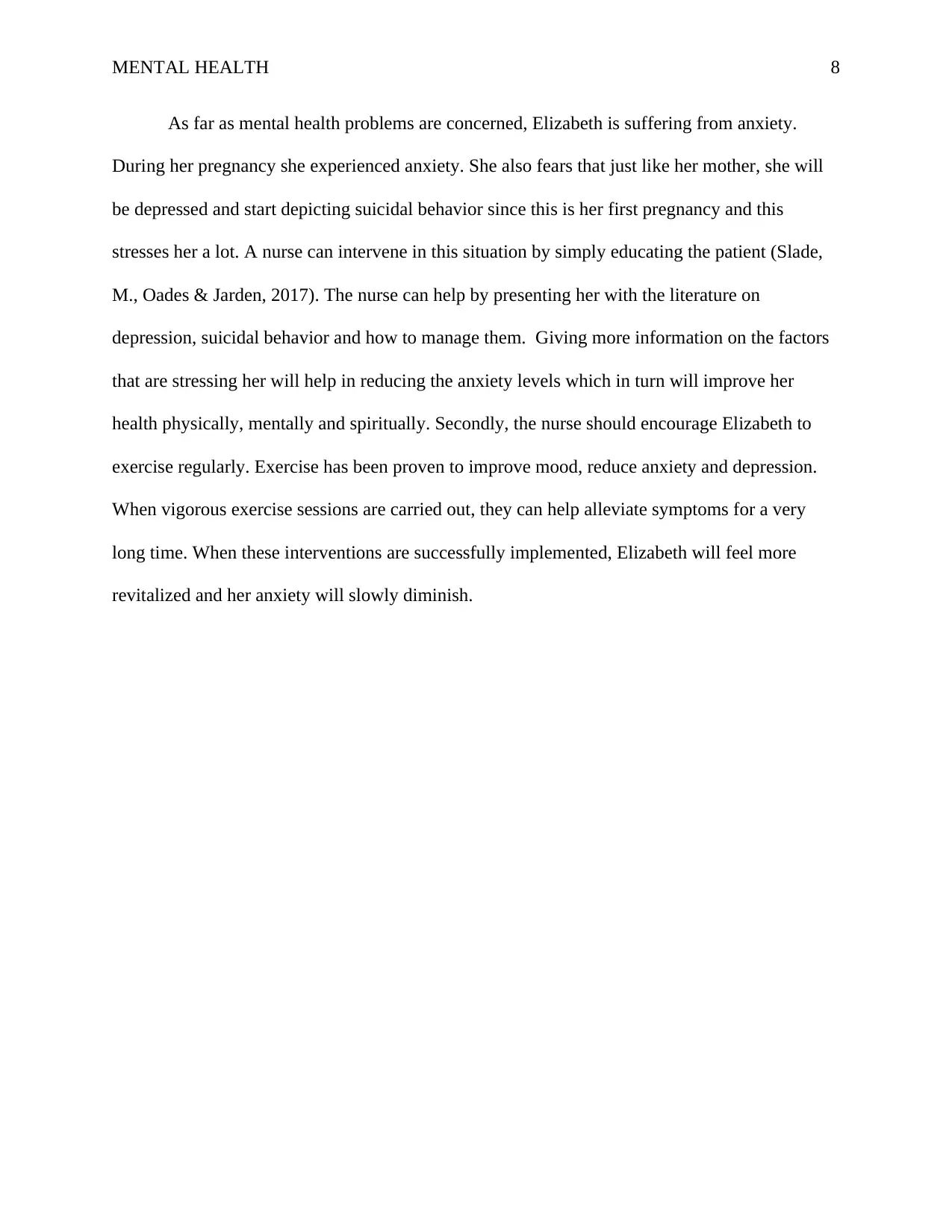
MENTAL HEALTH 8
As far as mental health problems are concerned, Elizabeth is suffering from anxiety.
During her pregnancy she experienced anxiety. She also fears that just like her mother, she will
be depressed and start depicting suicidal behavior since this is her first pregnancy and this
stresses her a lot. A nurse can intervene in this situation by simply educating the patient (Slade,
M., Oades & Jarden, 2017). The nurse can help by presenting her with the literature on
depression, suicidal behavior and how to manage them. Giving more information on the factors
that are stressing her will help in reducing the anxiety levels which in turn will improve her
health physically, mentally and spiritually. Secondly, the nurse should encourage Elizabeth to
exercise regularly. Exercise has been proven to improve mood, reduce anxiety and depression.
When vigorous exercise sessions are carried out, they can help alleviate symptoms for a very
long time. When these interventions are successfully implemented, Elizabeth will feel more
revitalized and her anxiety will slowly diminish.
As far as mental health problems are concerned, Elizabeth is suffering from anxiety.
During her pregnancy she experienced anxiety. She also fears that just like her mother, she will
be depressed and start depicting suicidal behavior since this is her first pregnancy and this
stresses her a lot. A nurse can intervene in this situation by simply educating the patient (Slade,
M., Oades & Jarden, 2017). The nurse can help by presenting her with the literature on
depression, suicidal behavior and how to manage them. Giving more information on the factors
that are stressing her will help in reducing the anxiety levels which in turn will improve her
health physically, mentally and spiritually. Secondly, the nurse should encourage Elizabeth to
exercise regularly. Exercise has been proven to improve mood, reduce anxiety and depression.
When vigorous exercise sessions are carried out, they can help alleviate symptoms for a very
long time. When these interventions are successfully implemented, Elizabeth will feel more
revitalized and her anxiety will slowly diminish.
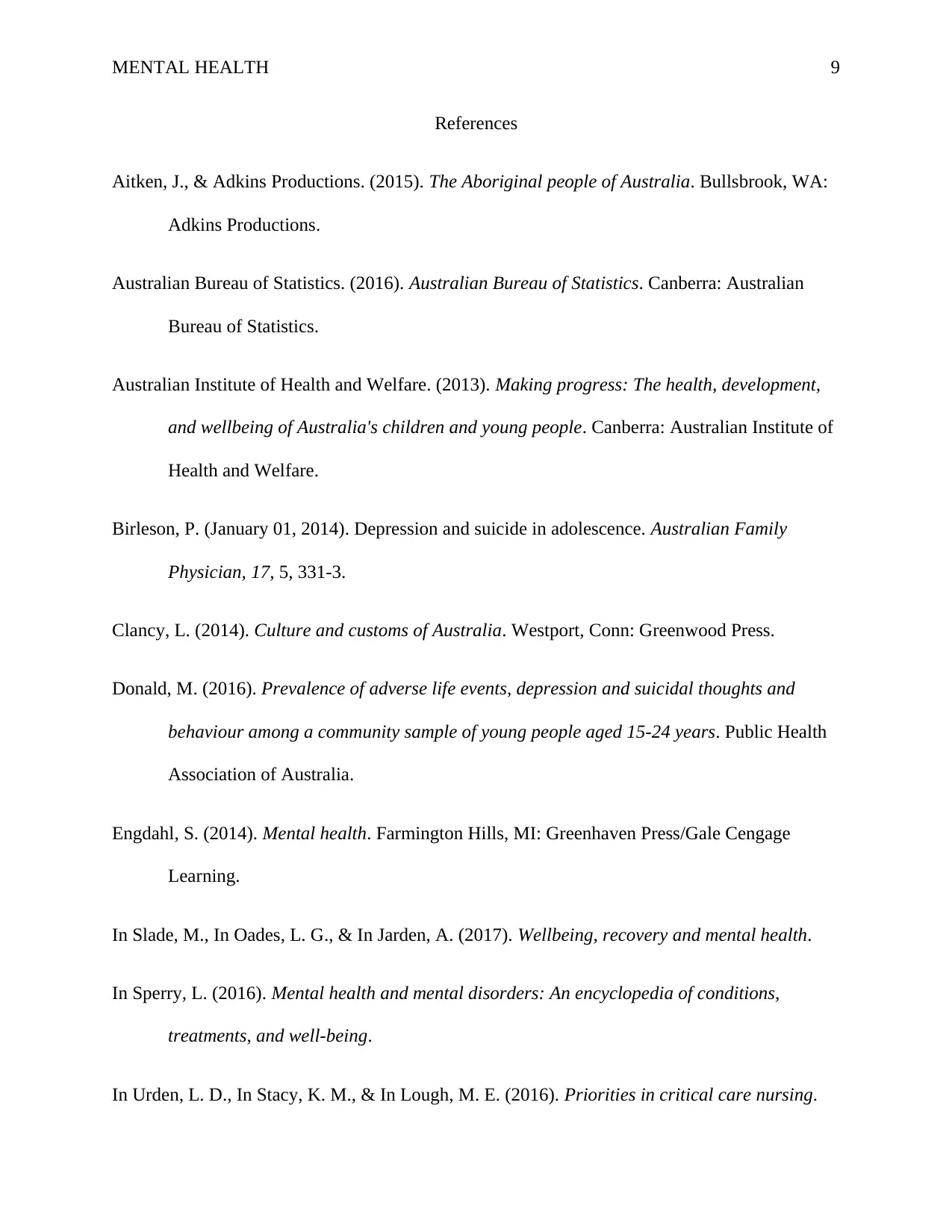
MENTAL HEALTH 9
References
Aitken, J., & Adkins Productions. (2015). The Aboriginal people of Australia. Bullsbrook, WA:
Adkins Productions.
Australian Bureau of Statistics. (2016). Australian Bureau of Statistics. Canberra: Australian
Bureau of Statistics.
Australian Institute of Health and Welfare. (2013). Making progress: The health, development,
and wellbeing of Australia's children and young people. Canberra: Australian Institute of
Health and Welfare.
Birleson, P. (January 01, 2014). Depression and suicide in adolescence. Australian Family
Physician, 17, 5, 331-3.
Clancy, L. (2014). Culture and customs of Australia. Westport, Conn: Greenwood Press.
Donald, M. (2016). Prevalence of adverse life events, depression and suicidal thoughts and
behaviour among a community sample of young people aged 15-24 years. Public Health
Association of Australia.
Engdahl, S. (2014). Mental health. Farmington Hills, MI: Greenhaven Press/Gale Cengage
Learning.
In Slade, M., In Oades, L. G., & In Jarden, A. (2017). Wellbeing, recovery and mental health.
In Sperry, L. (2016). Mental health and mental disorders: An encyclopedia of conditions,
treatments, and well-being.
In Urden, L. D., In Stacy, K. M., & In Lough, M. E. (2016). Priorities in critical care nursing.
References
Aitken, J., & Adkins Productions. (2015). The Aboriginal people of Australia. Bullsbrook, WA:
Adkins Productions.
Australian Bureau of Statistics. (2016). Australian Bureau of Statistics. Canberra: Australian
Bureau of Statistics.
Australian Institute of Health and Welfare. (2013). Making progress: The health, development,
and wellbeing of Australia's children and young people. Canberra: Australian Institute of
Health and Welfare.
Birleson, P. (January 01, 2014). Depression and suicide in adolescence. Australian Family
Physician, 17, 5, 331-3.
Clancy, L. (2014). Culture and customs of Australia. Westport, Conn: Greenwood Press.
Donald, M. (2016). Prevalence of adverse life events, depression and suicidal thoughts and
behaviour among a community sample of young people aged 15-24 years. Public Health
Association of Australia.
Engdahl, S. (2014). Mental health. Farmington Hills, MI: Greenhaven Press/Gale Cengage
Learning.
In Slade, M., In Oades, L. G., & In Jarden, A. (2017). Wellbeing, recovery and mental health.
In Sperry, L. (2016). Mental health and mental disorders: An encyclopedia of conditions,
treatments, and well-being.
In Urden, L. D., In Stacy, K. M., & In Lough, M. E. (2016). Priorities in critical care nursing.
⊘ This is a preview!⊘
Do you want full access?
Subscribe today to unlock all pages.

Trusted by 1+ million students worldwide
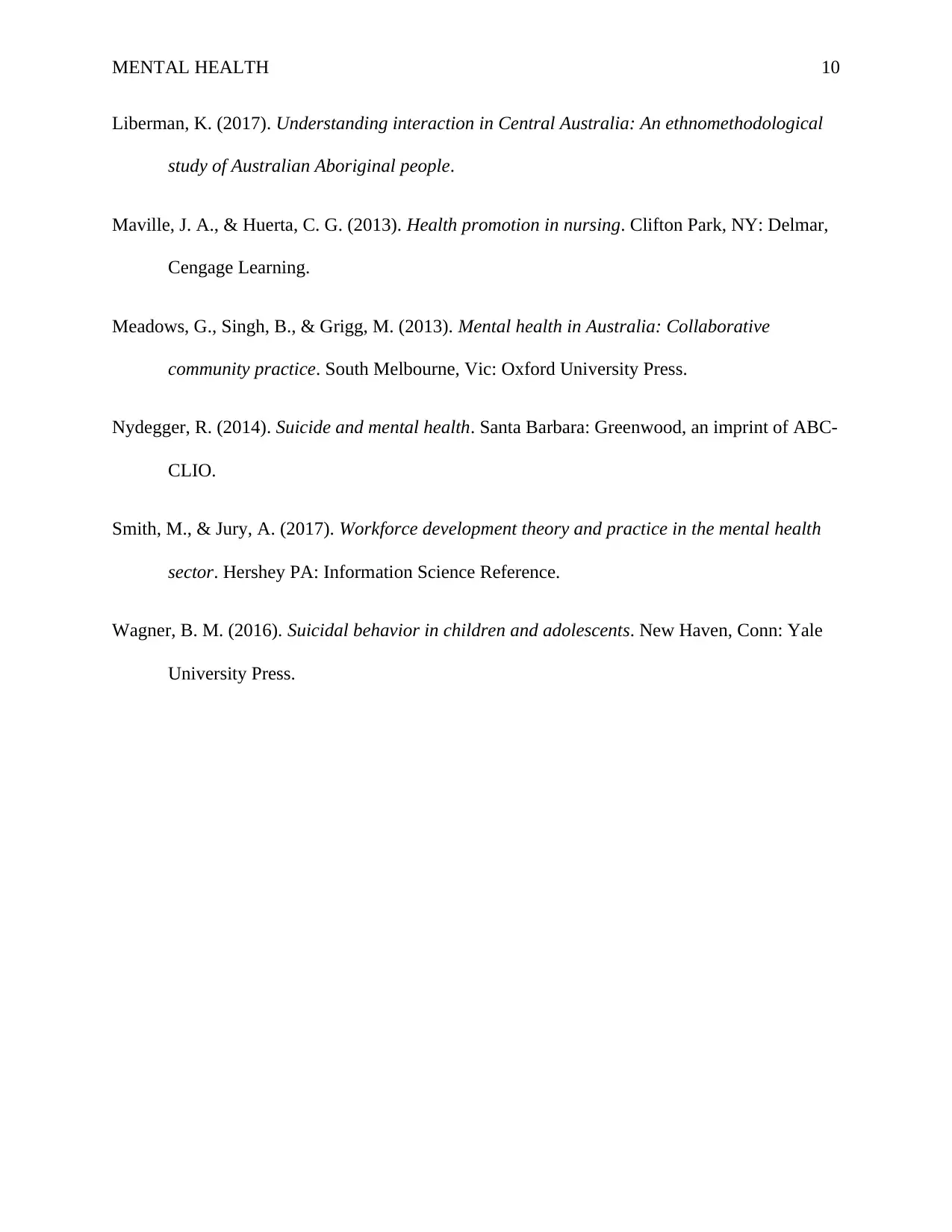
MENTAL HEALTH 10
Liberman, K. (2017). Understanding interaction in Central Australia: An ethnomethodological
study of Australian Aboriginal people.
Maville, J. A., & Huerta, C. G. (2013). Health promotion in nursing. Clifton Park, NY: Delmar,
Cengage Learning.
Meadows, G., Singh, B., & Grigg, M. (2013). Mental health in Australia: Collaborative
community practice. South Melbourne, Vic: Oxford University Press.
Nydegger, R. (2014). Suicide and mental health. Santa Barbara: Greenwood, an imprint of ABC-
CLIO.
Smith, M., & Jury, A. (2017). Workforce development theory and practice in the mental health
sector. Hershey PA: Information Science Reference.
Wagner, B. M. (2016). Suicidal behavior in children and adolescents. New Haven, Conn: Yale
University Press.
Liberman, K. (2017). Understanding interaction in Central Australia: An ethnomethodological
study of Australian Aboriginal people.
Maville, J. A., & Huerta, C. G. (2013). Health promotion in nursing. Clifton Park, NY: Delmar,
Cengage Learning.
Meadows, G., Singh, B., & Grigg, M. (2013). Mental health in Australia: Collaborative
community practice. South Melbourne, Vic: Oxford University Press.
Nydegger, R. (2014). Suicide and mental health. Santa Barbara: Greenwood, an imprint of ABC-
CLIO.
Smith, M., & Jury, A. (2017). Workforce development theory and practice in the mental health
sector. Hershey PA: Information Science Reference.
Wagner, B. M. (2016). Suicidal behavior in children and adolescents. New Haven, Conn: Yale
University Press.
Paraphrase This Document
Need a fresh take? Get an instant paraphrase of this document with our AI Paraphraser

MENTAL HEALTH 11
1 out of 11
Related Documents
Your All-in-One AI-Powered Toolkit for Academic Success.
+13062052269
info@desklib.com
Available 24*7 on WhatsApp / Email
![[object Object]](/_next/static/media/star-bottom.7253800d.svg)
Unlock your academic potential
Copyright © 2020–2025 A2Z Services. All Rights Reserved. Developed and managed by ZUCOL.




